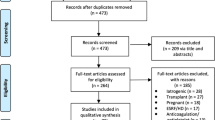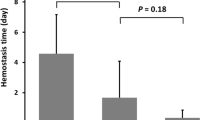Abstract
Purpose
To assess clinical presentation and outcomes of different treatment strategies in cases of spontaneous renal hemorrhage (SRH).
Methods
A retrospective analysis of patients with SRH between 2000 and 2018 was performed. Patients’ demographics, clinical presentation, laboratory and radiological investigations, and different lines of treatment were retrieved. The primary outcome was to assess the predictors of the success of conservative treatment. The secondary outcome was to assess the long-term renal function outcome comparing serum creatinine, e GFF, and CT-assessed renal volume at last follow-up with baseline values.
Results
The study included 42 (23 males and 19 women) patients with mean ± SD age was 48.1 ± 17.8 years. Conservative management was successful in 19 (46%) patients. Trans-arterial embolization (TAE) was performed in 13 patients (30%) to control active bleeding. Ten patients (25%) required surgical exploration and nephrectomy. Lower serum creatinine (P = 0.003), higher prothrombin concentration (P = 0.04), lower hematoma size (P = 0.02), and non-AML lesions (P = 0.03) were independent predictors of conservative management success. Unlike the TAE-treated group, serum creatinine increased significantly (P = 0.04) with a significant decrease in e-GFR (P = 0.02) and renal volume (P < 0.001) of affected kidneys at last follow-up after conservative treatment.
Conclusion
Although SRH is a life-threatening condition, conservative treatment is successful in a certain subset of patients. However, it is associated with significant deterioration of the affected kidney function as well as renal volume.
Similar content being viewed by others
References
Zhang JQ, Fielding JR, Zou KH (2002) Etiology of spontaneous perirenal hemorrhage: a meta-analysis. J Urol 167(4):1593–1596
Baishya RK, Dhawan DR, Sabnis R, Desai MR (2011) Spontaneous subcapsular renal hematoma: a case report and review of literature. Urol Ann 3(1):44
Ahn T, Roberts MJ, Navaratnam A, Chung E, Wood S (2017) Changing etiology and management patterns for spontaneous renal hemorrhage: a systematic review of contemporary series. Int Urol Nephrol 49(11):1897–1905
Ahn T, Roberts M, Navaratnam A, Hirst J, Wood S (2018) Recurrent spontaneous renal haemorrhage due to polyarteritis nodosa. ANZ J Surg 88(12):1347–1348
Chan Y, Morales J, Reidy J, Taylor P (2008) Management of spontaneous and iatrogenic retroperitoneal haemorrhage: conservative management, endovascular intervention or open surgery? Int J Clin Pract 62(10):1604–1613
Earley A, Miskulin D, Lamb EJ, Levey AS, Uhlig K (2012) Estimating equations for glomerular filtration rate in the era of creatinine standardization: a systematic review. Ann Intern Med 156(11):785–795
Breau RH, Clark E, Bruner B, Cervini P, Atwell T, Knoll G et al (2013) A simple method to estimate renal volume from computed tomography. Can Urol Assoc J 7(5–6):189–192
Harraz AM, EL-Nahas AR, Zahran MH, Abol-Enein H (2014) Would the indwelling internal ureteral stent influence renal function despite relief of benign ureteral obstruction? J Endourol 28(2):243–247
Mcdougal WS, Kursh ED, Persky L (1975) Spontaneous rupture of the kidney with perirenal hematoma. J Urol 114(2):181–184
Grubb SM, Stuart JI, Harper HM (2017) Sudden onset flank pain: spontaneous renal rupture. Am J Emerg Med 35(11):1787
Agarwal B, Gatt A, Riddell A, Wright G, Chowdary P, Jalan R et al (2013) Hemostasis in patients with acute kidney injury secondary to acute liver failure. Kidney Int 84(1):158–163
Ichigi Y, Takaki N, Nakamura K, Sato S, Kato A, Matsuo Y et al (1999) Significance of hematoma size for evaluating the grade of blunt renal trauma. Int J Urol 6(10):502–508
Keihani S, Myers J (2018) Re: perinephric hematoma size is independently associated with the need for urological intervention in multisystem blunt renal trauma. J Urol 200(3):656–657
Zemp L, Mann U, Rourke KF (2018) Perinephric hematoma size is independently associated with the need for urological intervention in multisystem blunt renal trauma. J Urol 199(5):1283–1288
Keller MS, Coln CE, Garza JJ, Sartorelli KH, Green MC, Weber TR (2004) Functional outcome of nonoperatively managed renal injuries in children. J Trauma Acute Care Surg 57(1):108–110
McCombie SP, Thyer I, Corcoran NM, Rowling C, Dyer J, Le Roux A et al (2014) The conservative management of renal trauma: a literature review and practical clinical guideline from Australia and New Zealand. BJU Int 114(Suppl 1):13–21
Palmerola R, Patel V, Hartman C, Sung C, Hoenig D, Smith AD et al (2017) Renal functional outcomes are not adversely affected by selective angioembolization following percutaneous nephrolithotomy. Asian J Urol 4(1):27–30
Saour M, Charbit J, Millet I, Monnin V, Taourel P, Klouche K et al (2014) Effect of renal angioembolization on post-traumatic acute kidney injury after high-grade renal trauma: a comparative study of 52 consecutive cases. Injury 45(5):894–901
Collins CS, Eggert CH, Stanson AJ, Garovic VD (2010) Long-term follow-up of renal function and blood pressure after selective renal arterial embolization. Perspect Vasc Surg Endovasc Ther 22(4):254–260
Al-Qudah HS, Santucci RA (2006) Complications of renal trauma. Urol Clin 33(1):41–53
Funding
Authors states that there was no funding received.
Author information
Authors and Affiliations
Contributions
Elbaset MA: patients’ follow-up and statistical analysis and manuscript writing; Mohamad H Zahran: manuscript editing; Ramy EL-Baz: data collection; Mohamed Badawy: radiology data supervision; Yasser Osman: study supervision and manuscript revision.
Corresponding author
Ethics declarations
Conflict of interest
The authors declare that they have no conflict of interest.
Human and animal rights
All procedures in this study involving human participants were in accordance with the ethical standards of the institutional committee and with the 1964 Helsinki Declaration and its later amendments.
Informed consent
Informed consent was obtained from all individual participants included in the study.
Additional information
Publisher's Note
Springer Nature remains neutral with regard to jurisdictional claims in published maps and institutional affiliations.
Rights and permissions
About this article
Cite this article
Elbaset, M.A., Zahran, M.H., EL-Baz, R. et al. Spontaneous renal hemorrhage: critical analysis of different lines of management in non-traumatic patients: a single tertiary center experience. Int Urol Nephrol 52, 423–429 (2020). https://doi.org/10.1007/s11255-019-02333-9
Received:
Accepted:
Published:
Issue Date:
DOI: https://doi.org/10.1007/s11255-019-02333-9




